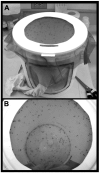Culturing and egg collection of Aedes aegypti
- PMID: 20889704
- PMCID: PMC2966317
- DOI: 10.1101/pdb.prot5507
Culturing and egg collection of Aedes aegypti
Abstract
Blood-feeding mosquitoes, including the dengue and yellow fever vector Aedes aegypti, transmit many of the world's deadliest diseases. Such diseases have resurged in developing countries and pose clear threats for epidemic outbreaks in developed countries. Recent mosquito genome projects have stimulated interest in the potential for arthropod-borne disease control by genetic manipulation of vector insects, and genes that regulate development are of particular interest. This protocol describes methods for culturing Ae. aegypti and includes a procedure for egg collection that can be used in conjunction with fixation, immunohistochemistry, and in situ protocols.
Conflict of interest statement
Conflicts of interest: none declared
Figures
References
-
- Christophers SR. Aedes aegypti, The yellow fever mosquito: its life history, bionomics, and structure. Cambridge University Press; Cambridge, UK: 1960.
-
- Lobo NF, Clayton JR, Fraser MJ, Kafatos FC, Collins FH. High efficiency germ-line transformation of mosquitoes. Nat Protoc. 2006;1:1312–1317. - PubMed
Publication types
MeSH terms
Grants and funding
LinkOut - more resources
Full Text Sources

